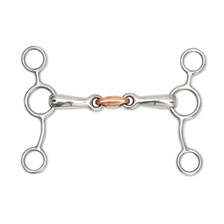Shires
Shires Bevel with Copper Lozenge Bit
- Availability:
- Please note, for reasons of health and hygiene this bit is non-returnable if removed from the template, or has evidence it has been placed inside the horses mouth.
Shires Bevel with Copper Lozenge
Allowing the application of mild leverage, the Shires Bevel with Copper Lozenge promotes correct head carriage when the cheeks tilt forward, causing the mouthpiece to slightly lift in the mouth. It is especially good for horses who tend to need slightly more than a Snaffle but do not require the harshness of a gag and is popular in showing circles. The bit has two rein options, the first when a rein is attached to the main, large outer ring allows poll pressure to be applied, or the second option where the rein is attached to the lower inner ring giving the action of a mild gag. The loose ring of a Bevel allows more movement than a fixed cheek alternative and further discourages leaning and tilting, encouraging the horse to soften and mouth at the bit. If fitted correctly, the loose ring should not rub or pinch the corners of the mouth or lips. This is further assisted by the warming affect of the copper lozenge. Mainly composed of Stainless Steel, this bit will not rust or tarnish and is easy to clean and maintain.
Shires Bevel with Copper Lozenge Features:
- Allows mild leverage and poll pressure to be applied.
- Two rein attachment options.
- Good for horses who tend to lean.
- A good option for horses needing slightly more control than a Snaffle.
- Features a warming Copper Lozenge.
- Popular in Showing circles.
- This bit is not British Dressage Legal.
- Available in 5 Sizes.
To measure your horse for a bit:
1. Having first selected the correct height stand in front of your horse (for safety, with your face turned to one side) and with your hands hold a contact with the bit. Approximately 5mm (1/4 inch) on each side is correct (a little more can be allowed for loose rings). As a guide there should be space to fit one finger between the horse's lips and bits ends on both sides.
There should be adequate space on both sides to clear the lips to prevent pinching but not so much that the bit can slide across the mouth.
2. Remove the bit and lay it flat on a firm surface. Measure between the two corners of the bit, inside to inside (C) to find the width size of your horse's mouth.
Country & Stable offer free* delivery on orders over £50, orders under this amount or those living in the Scottish Highlands or non mainland UK are £9.95.
Returning items is easy with Country & Stable - we offer free* returns with DPD simply scan the QR code on your returns form.
For more information please go to our Delivery & Returns page.













